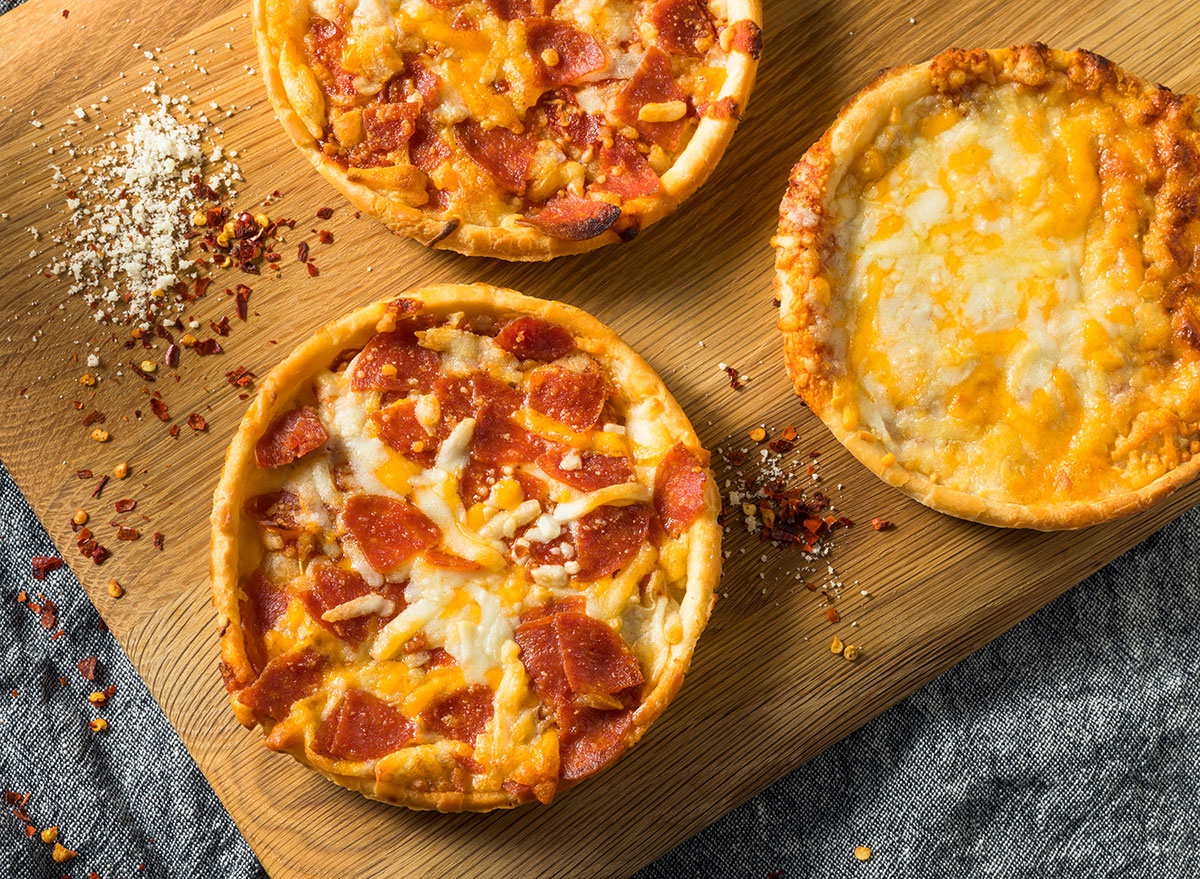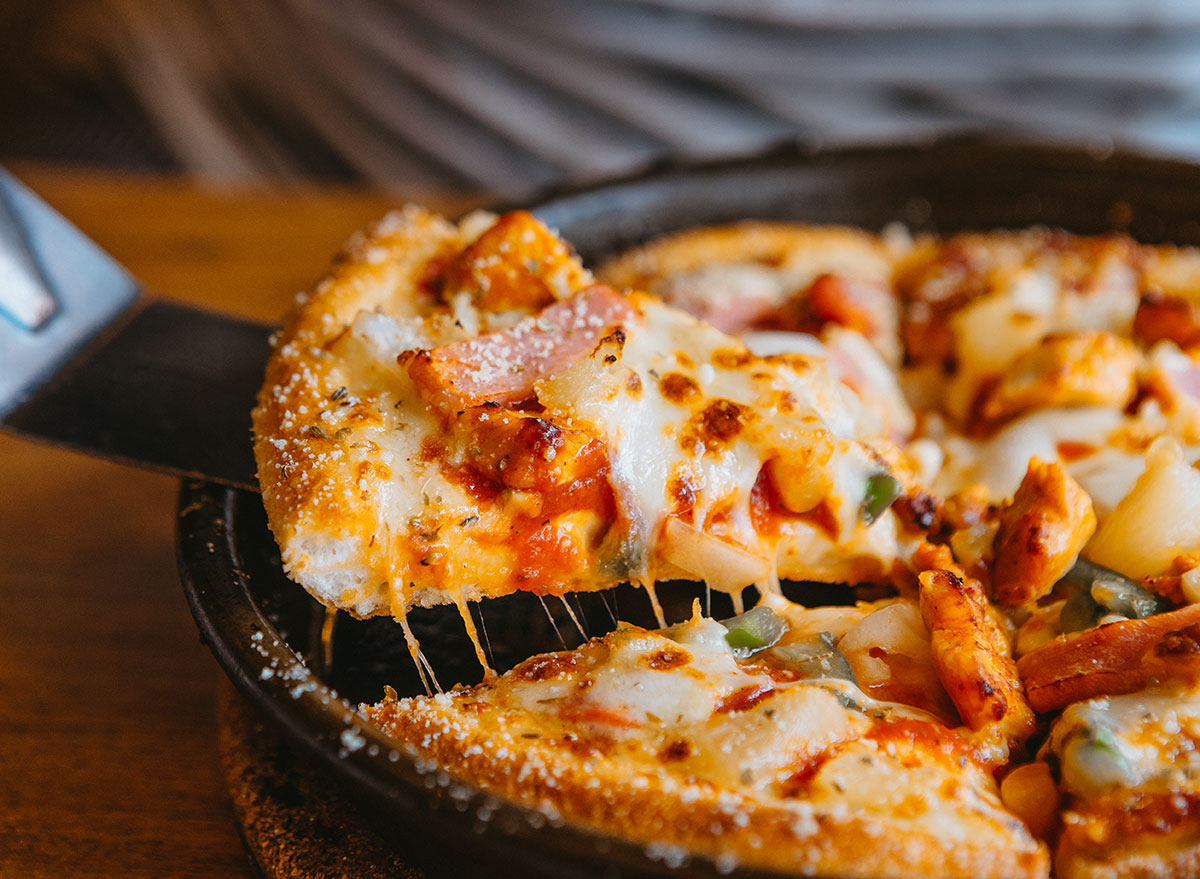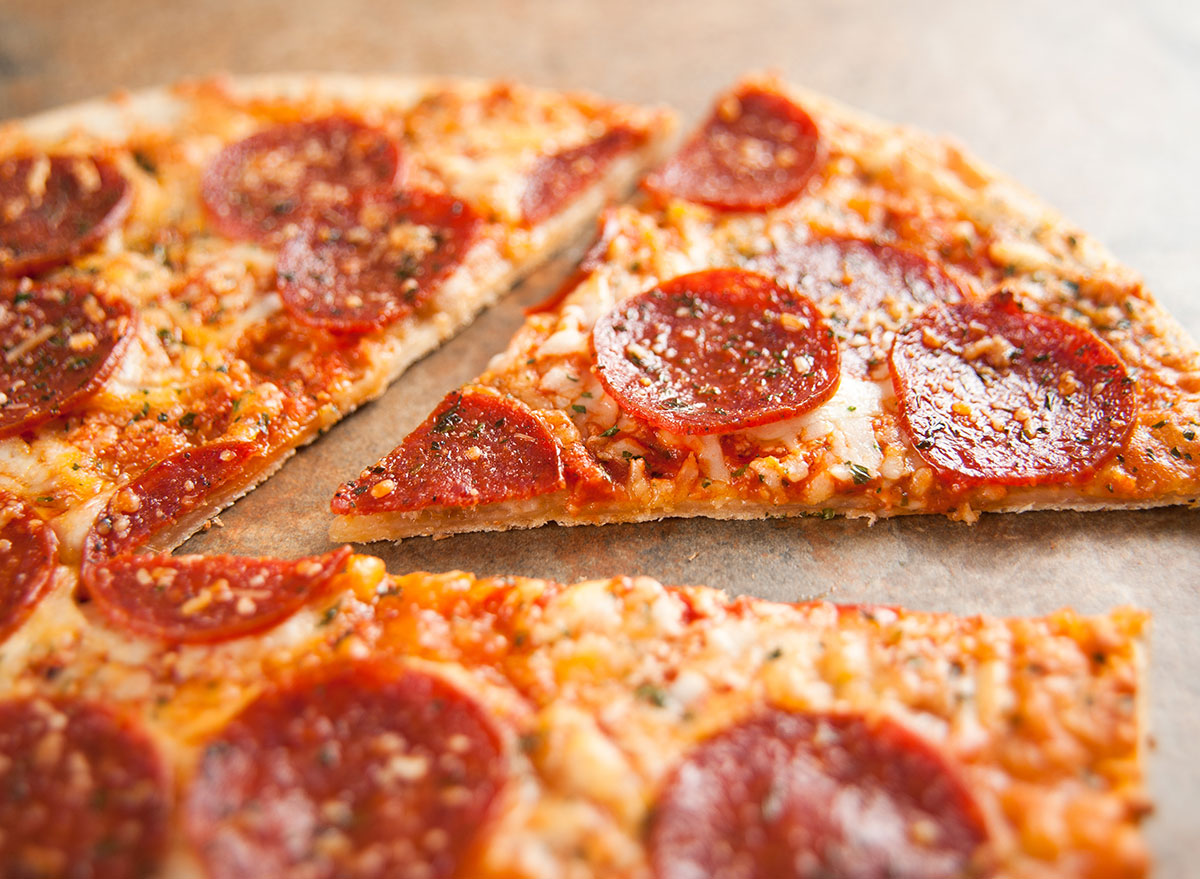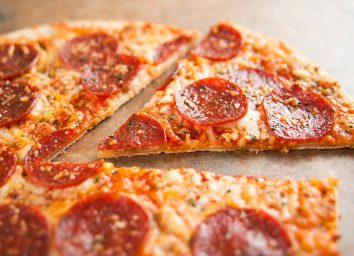One Major Side Effect of Eating Frozen Pizza, According to Science

Dinner doesn’t get much easier than ordering delivery from the local pizza shop unless you have a frozen pie in the freezer ready to pop into your oven. Then, you’re golden. Just sit back, crack open a beer, and wait for your piping hot “heart attack on a plate.”
Wait, what? It’s just a pizza!
Yes, and eating frozen pizza probably isn’t going to trigger a heart attack today. But if you dissect the typical packaged pizza from your supermarket and examine the ingredients, you’ll find that frozen pizzas deliver the perfect storm of heart-harming elements.
You know what they are—salt, sugar, saturated fats, refined carbohydrates—but you probably don’t think about them when you’re busy munching and trying to keep grease from dripping on your blouse. High amounts of all of those things raise your risk of heart attack and stroke. They also increase your odds of related metabolic disorders like high blood pressure, high cholesterol, high blood sugar, diabetes, and obesity, which in turn, elevate heart disease risk. If you ask yourself, what’s one major potential side effect of eating a lot of frozen pizza, it has to be heart disease. Let’s open a box and find out why with an eye toward nutritional science.
And “because it’s not delivery, it’s DiGiorno,” let’s take a closer look at the pie that we selected as the second-worst possible frozen pizza you can eat: DiGiorno Three Meat Croissant Crust Pizza. While this pie is just representative of the average frozen pizza in the freezer aisle, know that not all options are bad. Read on to learn about how frozen pizza isn’t good for heart health, and for more healthful options, check out 25 Best Healthy Frozen Pizza Pies, According to Dietitians.
More ingredients than grams of fat

If the name itself doesn’t tip you off to potential heart harm: “three meat,” “croissant,” “crust,” just have a look at the ingredients list. It’s 31 lines long and contains unfamiliar stuff like “propyl gallate” and “BHT.” An ingredients list that long and confusing is a sure sign of ultra-processed food, the kind that a study in the Journal of the American College of Cardiology found is associated with an increased risk of cardiovascular disease incidence and mortality. The researchers stressed that each additional daily serving of ultra-processed food, like frozen pizza, further increased risk while pointing out that 58% of the total calories in the average U.S. diet is highly processed.
Significant calories

One serving (1/5 of a pie) contains 410 calories. But when was the last time you ate just one slice of frozen pizza? Two slices contain 810 calories, which is half of the daily calories a sedentary woman in her mid-50s or older should consume. When you consume more daily calories than your body needs, the extra energy is stored as fat. Obesity has consistently been linked to cardiovascular disease in studies. For example, one meta-analysis of five studies involving more than 880,000 participants in JAMA Open Network showed that each five-point rise in body mass index (BMI) increased the odds of coronary artery disease by 20% and type 2 diabetes by 67%. Doctors from the Cleveland Clinic involved in the research said the findings are important because they conclude that excess fat itself on the body is harmful to the heart: “you cannot ignore the extra weight.”
Saturated fat

Of the 22 grams of fat in this frozen pie, 10 grams are saturated fats mostly coming from cheese, pork, and beef. In fact, all of that saturated fat is just shy of the 13 grams the American Heart Association recommends limiting per day. Diets high in saturated fats have been linked to heart problems like atherosclerosis, the buildup of fatty plaques on the inner walls of the arteries. Clinical research has shown that saturated fats can raise LDL “bad” cholesterol and put you at higher risk for heart disease.
For more, check out Eating Habits to Avoid if You Don’t Want High Cholesterol, Say Dietitians.
Sodium

Pizza is the second leading contributor of sodium in the U.S. diet, behind bread, according to the Center for Science in the Public Interest. The American Heart Association (AHA) has ranked pizza as one of its “Salty Six” foods that add significant amounts of sodium to the diet. Eating pizza on any given day gives you about a third of your sodium intake for the day. In the case of DiGiorno’s frozen pizza, you are getting 840 milligrams of sodium. The AHA recommends no more than 2,300 milligrams (mg) a day. If you already have high blood pressure, your doctor may recommend getting less than 1,500 mg per day since high blood pressure is a significant risk factor for heart disease. Salt causes your body to retain water. In some people, that action causes blood pressure to rise as the water puts added stress on your heart and blood vessels.
Sugar and refined carbohydrates

The average frozen pizza contains about 5 grams of sugars (this DiGiorno has 4 grams per slice). While that may not seem like a lot, remember that added sugars add up. You have to remember that you are getting them from many sources throughout the day. But in one serving of frozen pizza, you are getting 36 grams of something just as bad for your health: refined carbohydrates, that crust made from white flour, which contains very little fiber (just 2 grams per serving). Because pizza’s carbs are refined and low in fiber, they digest quickly, raising your blood sugar. This triggers a flood of insulin to deal with all of that glucose, which can lead to insulin resistance, the precursor to type 2 diabetes. According to the Centers for Disease Control and Prevention’s National Diabetes Statistics Report, type 2 diabetes puts adults at higher risk of death from heart disease over adults who do not have diabetes.
If you are a pizza lover, take heart: giving up frozen pizza doesn’t mean you can never enjoy another slice. You can make your pizza healthier by making it yourself at home. For delicious, healthy recipes for homemade pizza grab a copy of the Eat This, Not That! book The Pizza Diet: How I lost 100 Pounds Eating my Favorite Food—and You Can Too! by chef Pasquale Cozzolino.








